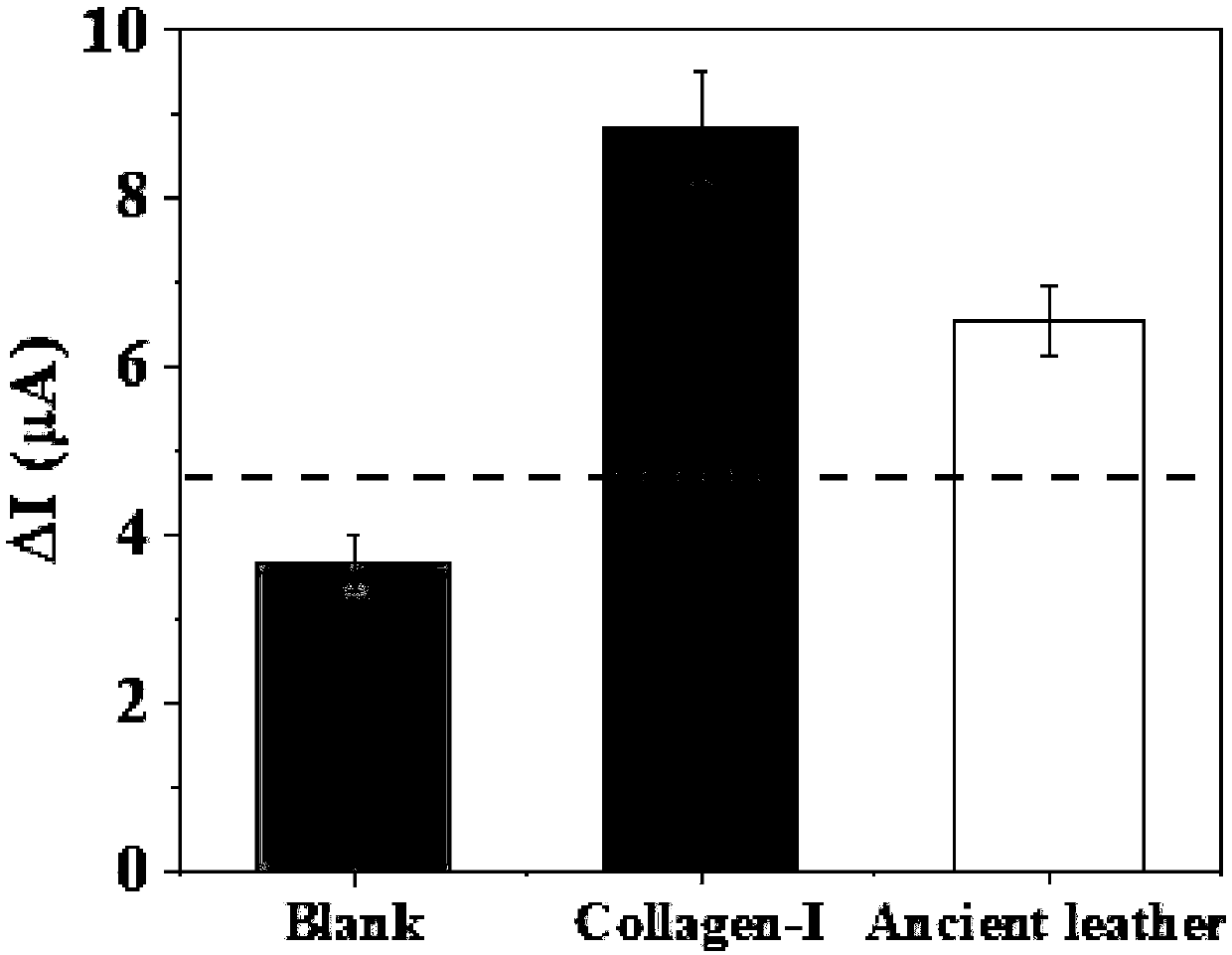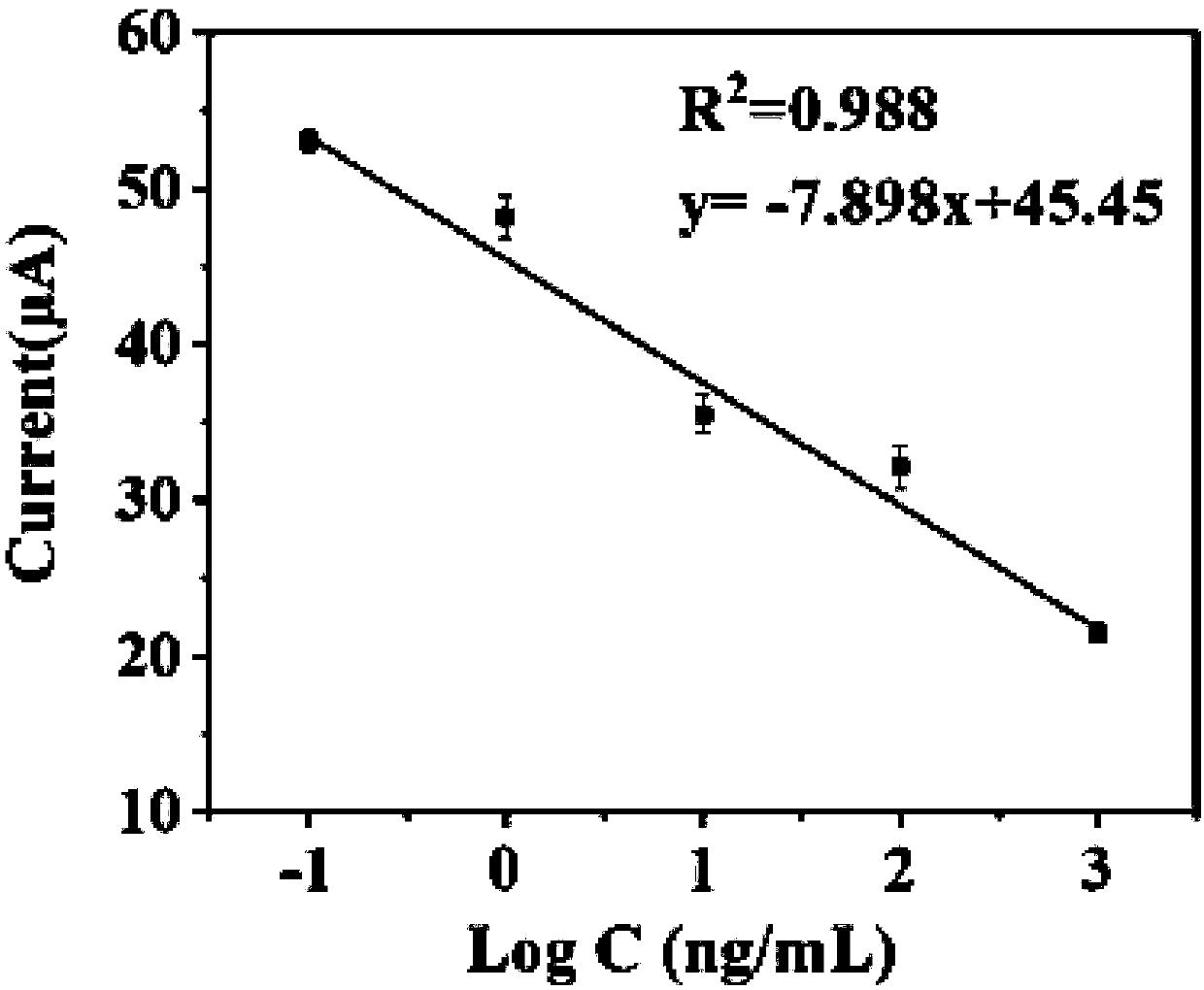High sensitivity detection method for cowhide cultural relic
A technology with high sensitivity and detection method, applied in the field of high-sensitivity detection of cowhide cultural relics, can solve problems such as difficulty in detection of cultural relics with extremely low protein content, and achieve the effects of high binding rate, high utilization efficiency and good load performance.
- Summary
- Abstract
- Description
- Claims
- Application Information
AI Technical Summary
Problems solved by technology
Method used
Image
Examples
Embodiment 1
[0040] A) Take 15 g of healthy adult cattle hide, cut it into small pieces of 2 cm × 2 cm, put it into a conical flask, soak and degrease it with 5% sodium carbonate aqueous solution in a 45°C incubator for 4 h. Take out the degreased cowhide, mix each 1 g of cowhide with 14 mL of 4% sodium chloride aqueous solution, stir slowly at room temperature for 12 h to remove the salt-soluble non-collagen components, and then wash and drain with distilled water.
[0041] B) Put the drained cowhide in a beaker, add pepsin, the amount of protease added is 2000 U / g cowhide, add 28 mL of 0.5 mol / L acetic acid to 1 g cowhide, and carry out enzymatic hydrolysis in a 37 ℃ incubator Reaction for 7 h. After enzymatic hydrolysis, filter, collect the filtrate, add sodium chloride for salting out, the concentration of sodium chloride is 3 mol / L, after salting out, centrifuge at 12000 r / min for 10 min, and dissolve the precipitate with 0.5 mol / L acetic acid Dialysis bags with a cutoff of 10,000 we...
Embodiment 2
[0055] A) Take 15 g of healthy adult cattle hide, cut it into small pieces of 2 cm × 2 cm, put it into a conical flask, soak and degrease it with 6% sodium carbonate aqueous solution in a 50°C thermostat for 4 h. Take out the degreased cowhide, mix each 1 g of cowhide with 15 mL of 4-6% sodium chloride aqueous solution, stir slowly at room temperature for 12 hours to remove salt-soluble non-collagen components, and then wash and drain with distilled water.
[0056] B) Put the drained cowhide in a beaker, add pepsin, the amount of protease added is 3000 U / g cowhide, add 30 mL of 0.5 mol / L acetic acid to 1 g cowhide, and carry out enzymatic hydrolysis in a 37 ℃ incubator React for 8 h. After enzymatic hydrolysis, filter, collect the filtrate, add sodium chloride for salting out, the concentration of sodium chloride is 3-5 mol / L, centrifuge at 12000 r / min for 10 min after salting out, and dissolve the precipitate in 0.5 mol / L acetic acid Dialyze for 3 days in a dialysis bag with...
Embodiment 3
[0068] A) Take 15 g of healthy adult cattle hide, cut it into small pieces of 2 cm×2 cm, put it into a conical flask, soak and degrease it with 7% sodium carbonate aqueous solution in a 55°C incubator for 4 h. Take out the degreased cowhide, mix each 1 g of cowhide with 16 mL of 4-6% sodium chloride aqueous solution, stir slowly at room temperature for 12 h to remove the salt-soluble non-collagen components, and then wash and drain with distilled water.
[0069] B) Put the drained cowhide in a beaker, add pepsin, the amount of protease added is 4000 U / g cowhide, add 32 mL of 0.5 mol / L acetic acid to 1 g cowhide, and carry out enzymatic hydrolysis in a 37 ℃ incubator React for 9 h. After enzymatic hydrolysis, filter, collect the filtrate, add sodium chloride for salting out, the concentration of sodium chloride is 3-5 mol / L, centrifuge at 12000 r / min for 10 min after salting out, and dissolve the precipitate in 0.5 mol / L acetic acid Dialyze for 3 days in a dialysis bag with a ...
PUM
 Login to View More
Login to View More Abstract
Description
Claims
Application Information
 Login to View More
Login to View More - R&D
- Intellectual Property
- Life Sciences
- Materials
- Tech Scout
- Unparalleled Data Quality
- Higher Quality Content
- 60% Fewer Hallucinations
Browse by: Latest US Patents, China's latest patents, Technical Efficacy Thesaurus, Application Domain, Technology Topic, Popular Technical Reports.
© 2025 PatSnap. All rights reserved.Legal|Privacy policy|Modern Slavery Act Transparency Statement|Sitemap|About US| Contact US: help@patsnap.com


